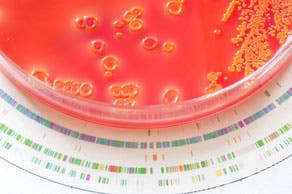Nov 4: Whole genome sequencing can improve resilience against antimicrobial resistant bacteria

By applying whole genome sequencing (WGS) in research, surveillance, and in the future in patient care of hospitalized patients, WGS can improve resilience against antimicrobial resistant bacteria, specifically ESBL-producing Escherichia coli. This was concluded by Tess Verschuuren in her research project for which she received a PhD from Utrecht University on November 4, 2021.
In 2019, the WHO named antimicrobial resistance (AMR) as one of the top 10 global public health threats, with high mortality and massive loss in gross domestic product by 2030. Proposed actions were, amongst others to increase understanding and awareness of AMR, to improve global surveillance and to optimize antimicrobial use. The studies in the PhD thesis by Tess Verschuuren (Department of Epidemiology of Infectious Diseases and Department of Medical Microbiology, UMC Utrecht) aimed to provide information on how resilience against extended-spectrum β-lactamase-producing Escherichia coli (ESBL-Ec) can be improved with practical applications of whole genome sequencing (WGS), with focus on (1) increasing scientific knowledge on which reservoirs contribute to human carriage and infection of ESBL-Ec, (2) improved detection and tracking of ESBL variants that circulate in the community with genetic surveillance, and (3) to revise antimicrobial susceptibility testing of E. coli infections.
Key findings
The most important findings reported by Tess Verschuuren in her PhD thesis are:
- The probability of E. coli to carry AMR is determined by its genetic backbone. Certain E. coli variants are responsible for a disproportionate burden of disease of AMR and might be of interest for direct infection prevention or vaccine development;
- A person’s own ESBL-Ec carriage in the gut is likely the most important source of an infection with ESBL-Ec;
- In Europe, human carriage is mostly caused by transmission from another human. Non-human sources like food or food animals are likely less common;
- There is some evidence for transfer of genetic material encoding AMR between ESBL-Ec and ESBL-producing Klebsiella pneumoniae. More research is needed to determine how important this type of transfer for development of AMR;
- ESBL-Ec detected in urine- and blood-cultures from routine clinical care give a representative view of the genetic variants of ESBL-Ec circulating in the Dutch community and clinical cultures are therefore suitable for genetic surveillance of ESBL-Ec;
- In the future, WGS could potentially be used as a quicker and more accurate method to select an antibiotic for treatment of hospitalized patients with a bacterial infection. Although the two AMR prediction methods tested here (KOVER-AMR and ResFinder 4.1) in an external validation study of 518 E. coli infections had shortcomings and did not meet FDA criteria, it is expected that improved WGS-based methods will be introduced in routine clinical care in the future.
Tess Verschuuren reflecting on the findings in her PhD thesis: “The studies in my thesis show that it is unlikely that ESBL-producing E. coli will disappear from Europe, as we observed a widespread occurrence of this bacterium in several reservoirs. However, the practical applications of WGS in science, public health, and patient care will improve our ability to understand, track, and treat ESBL-producing E. coli. In the grander scheme of things, it is expected that this development will change the way we look at bacteria, from a taxonomic view of pathogens, to a contextual view of the microbial world, where pathobionts are mostly beneficial, and sometimes pathogenic.”
Whole genome sequencing
Whole genome sequencing (WGS), where the nucleotide order of the entire DNA of an organism is determined, can characterize E. coli in the highest possible genetic resolution. The genomic sequence of a bacterium can be used for several purposes: (1) bacterial identification, (2) inferring phylogenetic relations, that in turn can be used for molecular surveillance, or to assess transmission, and (3) prediction of certain bacterial traits, amongst others AMR. Such applications make WGS the ideal methodology for molecular epidemiologic research, genetic surveillance, and potentially clinical antimicrobial susceptibility testing. Furthermore, the digital output can be endlessly stored, re-analyzed, and shared. These factors improve reproducibility and consequently the quality of research, surveillance, and clinical diagnostics.
PhD defense
Tess Verschuuren, MD (1990, Erp) defended her PhD thesis on November 4, 2021 at Utrecht University. The title of her thesis is “Practical applications of whole genome sequencing for reservoir epidemiology, molecular surveillance, and antimicrobial susceptibility testing of extended-spectrum beta-lactamase Escherichia coli”. Supervisors were prof. dr. Jan Kluytmans (Department of Epidemiology of Infectious Diseases and Department of Medical Microbiology, UMC Utrecht) and prof. dr. Rob Willems (Department of Medical Microbiology, UMC Utrecht). Co-supervisor was dr. Thijs Bosch (Head of the Diagnostic Laboratory for Bacteriology and Parasitology, RIVM). Early 2022, Tess Verschuuren intends to continue her research on molecular infectious disease epidemiology in Bangkok (Thailand).
